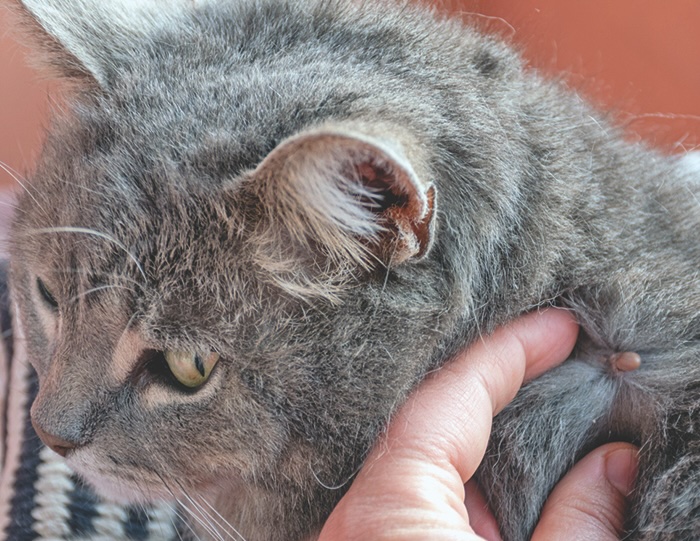Flea and tick control has improved by leaps and bounds over the past two decades. Gone are the dreaded weekly fights of baths or dips. Today’s collars, topicals, and systemic flea and tick preventatives make controlling these common parasites simple, and they are generally effective if utilized correctly as part of a comprehensive parasite prevention plan for your cat.
You can still use those powders, mousse preparations, and sprays if you wish, and many work well, provided you use them as directed. Flea combs are simple and somewhat effective, but they only remove the fleas on your cat at one given time, and do not address the life cycle of fleas. They are, of course, also labor intensive to use.
 “Most of my clients prefer topical products over a Seresto collar or an oral product such as Credelio,” says Leni Kaplan, DVM, senior lecturer at Cornell University’s College of Veterinary Medicine. These have drawbacks, too, of course. Collars can get caught on things, including other cats’ mouths when wrestling. Oral medications are almost always a challenge when dealing with cats. Overall, topical treatments are simpler and effective.
“Most of my clients prefer topical products over a Seresto collar or an oral product such as Credelio,” says Leni Kaplan, DVM, senior lecturer at Cornell University’s College of Veterinary Medicine. These have drawbacks, too, of course. Collars can get caught on things, including other cats’ mouths when wrestling. Oral medications are almost always a challenge when dealing with cats. Overall, topical treatments are simpler and effective.

No Resistance Problems
Periodically, rumors emerge about fleas and ticks developing resistance to common parasite control medications. Dr. Kaplan suggests that we should not believe all the scuttlebutt. “I am not seeing resistance,” says Dr. Kaplan. “There were two scientific publications in the past 10 years checking for flea and tick resistance to these compounds, and none has been found.”
Reasons a given product may not work include:
- Failing to give the preventive consistently each month
- Not treating ALL household pets (dogs and cats)
- Incorrect application of the topical (it needs to be applied to the skin—if product wicks up the hair, the pet does not receive the appropriate dose for her size)
- The product may be overwhelmed by the number of fleas and ticks in the pet’s environment, which is why it appears as if there is resistance.
“It is crucial that the indoor and outdoor environments are treated for fleas and ticks as well as the pets,” says Dr. Kaplan.
Following the directions exactly as written is important for many reasons. The medications have a limited time of effectiveness. If the product says to apply every 4 weeks, it might be working up until 4 ½ weeks, but don’t count on it.
And forget thinking it’s still working at 5 or 6 weeks. If you let the flea population gain a foothold again due to your lack of compliance, you will need to start all over, including a major environmental cleanup.
Found a Flea?
If you find fleas on one pet, treat all the pets. Dogs tend to go swimming and get bathed more frequently than most cats, so their flea population may be smaller and harder to identify. If you have a rabbit, he may need treatment as well.
If you find a flea, start with a bath. A heavily infested cat or kitten will benefit from a bath right away to remove and kill adult fleas that can cause anemia and to remove flea eggs and flea dirt. This is most effective if done before moving the kitten or cat to a new, clean environment and starting a preventive.
When you use the preventive medication, proper application means following the directions exactly. You need to part the hair to apply most topicals directly to the skin. To do this carefully, you may need to recruit a family member or friend to lightly restrain your cat with ear and chin rubs while you carefully apply the drug. If your cat has a heavy flea infestation, it pays to bathe the cat first to remove eggs, dirt, and any adult fleas on your cat at that moment. Then you can apply whatever flea control product you plan to use.
Indoor Cats, Too
Flea and tick control is important for all cats and is recommended all year round. That means even your indoor cat should be on a treatment plan. Fleas can come in on you, your clothing, and your other pets. If mice can get into your house, they can bring fleas and ticks. If your cat goes on walks on a harness and leash or has a catio to the outside, she can pick up fleas outside.
With indoor-only cats, you can win the flea battle. Start by tackling the environment. Fleas like cracks and dark, quiet places. Think under furniture, in the gaps where floors and walls meet, any cracks or crevices in your home.
A thorough vacuuming of the entire house, including upholstery and especially dark corners, is a good start. Right after you finish, empty your canister into a bag you can seal. Then put the bag in an outdoor trash container with a cover. You don’t want to take any chances of a flea surviving the vacuuming and getting back into the house.
If you have a severe or stubborn flea infestation, you may want to either “bomb” your house with a commercial product that kills fleas or have a pest control company come and spray while you and all the pets are out of the house. If you do the bombing yourself, you must do all rooms plus the basement. Open closet doors and spray them. Make sure dishes, food products, and fish tanks are safely covered.





